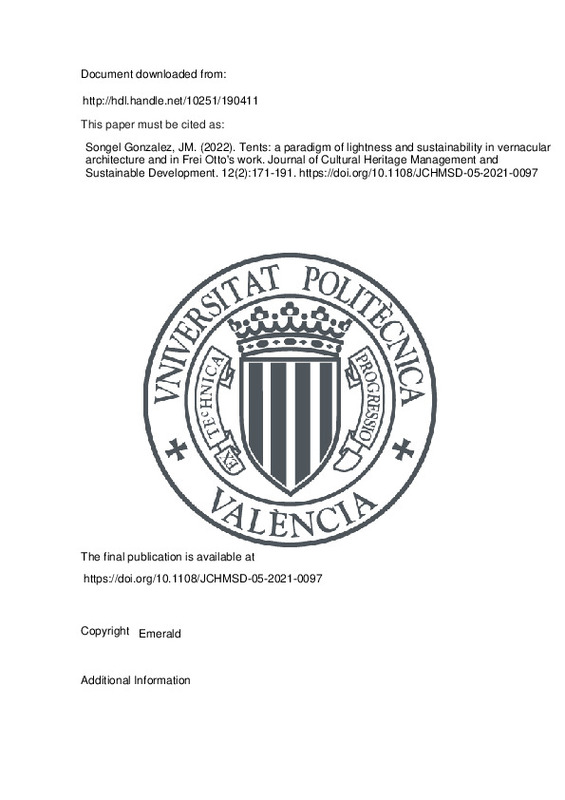JavaScript is disabled for your browser. Some features of this site may not work without it.
Buscar en RiuNet
Listar
Mi cuenta
Estadísticas
Ayuda RiuNet
Admin. UPV
Tents: a paradigm of lightness and sustainability in vernacular architecture and in Frei Otto's work
Mostrar el registro sencillo del ítem
Ficheros en el ítem
| dc.contributor.author | Songel Gonzalez, Juan María
|
es_ES |
| dc.date.accessioned | 2022-11-30T19:01:38Z | |
| dc.date.available | 2022-11-30T19:01:38Z | |
| dc.date.issued | 2022-04-26 | es_ES |
| dc.identifier.issn | 2044-1266 | es_ES |
| dc.identifier.uri | http://hdl.handle.net/10251/190411 | |
| dc.description.abstract | [EN] Purpose The aim of this paper is to explore the relationship between vernacular architecture and Frei Otto's work, searching for shared principles and specific singularities, and testing whether lightness and sustainability can be identified as a common goal. Design/methodology/approach The study is focused on tents and yurts, as archetypal examples of traditional architecture, and membrane structures and gridshells, as two types of light structures developed by Frei Otto. A comparative analysis of their behavior, form, elements, types, materials and strength has been carried out. Findings The survey carried out shows that Frei Otto's innovative tents and gridshells were not based on form imitation of vernacular architecture, but rather on a thorough understanding of physical form-generating processes, driving specific materials to optimal form, like his experiments with soap film models to generate tensioned minimal surfaces or his experiments with hanging chain net models to generate compressive antifunicular lattice shells. Originality/value This paper highlights how Frei Otto's endeavor to get the maximum with the minimum, to achieve a lot from a little, is also a key target of lightness and sustainability, and an essential feature of vernacular architecture. | es_ES |
| dc.language | Inglés | es_ES |
| dc.publisher | Emerald | es_ES |
| dc.relation.ispartof | Journal of Cultural Heritage Management and Sustainable Development | es_ES |
| dc.rights | Reconocimiento - No comercial (by-nc) | es_ES |
| dc.subject | Vernacular architecture | es_ES |
| dc.subject | Frei Otto | es_ES |
| dc.subject | Tents | es_ES |
| dc.subject | Membrane structures | es_ES |
| dc.subject | Yurts | es_ES |
| dc.subject | Gridshells | es_ES |
| dc.subject | Tensile architecture | es_ES |
| dc.subject | Light structures | es_ES |
| dc.subject | Sustainability | es_ES |
| dc.subject.classification | COMPOSICION ARQUITECTONICA | es_ES |
| dc.title | Tents: a paradigm of lightness and sustainability in vernacular architecture and in Frei Otto's work | es_ES |
| dc.type | Artículo | es_ES |
| dc.identifier.doi | 10.1108/JCHMSD-05-2021-0097 | es_ES |
| dc.rights.accessRights | Abierto | es_ES |
| dc.contributor.affiliation | Universitat Politècnica de València. Escuela Técnica Superior de Arquitectura - Escola Tècnica Superior d'Arquitectura | es_ES |
| dc.description.bibliographicCitation | Songel Gonzalez, JM. (2022). Tents: a paradigm of lightness and sustainability in vernacular architecture and in Frei Otto's work. Journal of Cultural Heritage Management and Sustainable Development. 12(2):171-191. https://doi.org/10.1108/JCHMSD-05-2021-0097 | es_ES |
| dc.description.accrualMethod | S | es_ES |
| dc.relation.publisherversion | https://doi.org/10.1108/JCHMSD-05-2021-0097 | es_ES |
| dc.description.upvformatpinicio | 171 | es_ES |
| dc.description.upvformatpfin | 191 | es_ES |
| dc.type.version | info:eu-repo/semantics/publishedVersion | es_ES |
| dc.description.volume | 12 | es_ES |
| dc.description.issue | 2 | es_ES |
| dc.relation.pasarela | S\463897 | es_ES |
| dc.subject.ods | 11.- Conseguir que las ciudades y los asentamientos humanos sean inclusivos, seguros, resilientes y sostenibles | es_ES |







![[Cerrado]](/themes/UPV/images/candado.png)

